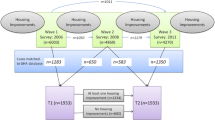Abstract
Objectives
This study aimed to investigate the relationship between housing, demographic, socio-economic, social factors and health, in poor urban communities in Johannesburg, South Africa.
Methods
Data were drawn from a survey of 1,427 households in Johannesburg. The outcome health variable was a composite measure of chronic ill-health. Housing variables included type of housing, tenure and access to services. Multivariate regression analysis assessed the relationship between housing and health, after adjustment for demographic, socio-economic and social factors.
Results
The prevalence of chronic health problems was 25.1% (95% CI 22.8–27.6%). Factors independently associated with the risk of chronic ill-health among household heads included older age (OR, 3.06 [2.37–3.95]), female gender (OR, 2.83 [2.01–3.97]), long-term residence (OR, 2.01 [1.10–3.67]), unemployment (OR, 0.49 [0.36–0.67]), and living in formal housing (OR, 0.66 [0.45–0.98]).
Conclusions
The health of the household heads residing in informal housing was significantly better than in formal housing. Explanations for this counter-intuitive finding include the fact that the informal housing dwellers were younger and recent migrants (the ‘healthy migrant’ phenomenon). Policy implications of the results are identified.
Similar content being viewed by others
References
Beall J, Crankshaw O, Parnell S (2000) Local government poverty reduction and inequality in Johannesburg. Environ Urban 12:107–122
City of Johannesburg (2005) Human Development Strategy Joburg’s commitment to the poor. http://www.joburg-archive.co.za/city_vision/hr_strategy-05.pdf. Accessed 9 December 2005
Coates J, Swindale A, Bilinsky P (2006) Household food insecurity access scale (HFIAS) for measurement of household food access: indicator guide. Food and nutrition technical assistance project. Academy for educational development, Washington
CSDA (2007) 2007 Johannesburg Livelihoods Survey Training Manual. Centre for Social Development in Africa; Community Agency for Social Enquiry, Johannesburg
Cunningham S, Ruben J, Narayan V (2008) Health of foreign-born people in the United States: a review. Health Place 14:623–635
De Wet T, Patel L, Korth M, Forrester C (2008) Johannesburg poverty and livelihoods study. Centre for Social Development in Africa, Johannesburg
Dunn JR (2002) Housing and inequalities in health: a study of socioeconomic dimensions of housing and self-reported health from a survey of Vancouver residents. J Epidemiol Community Health 56:671–681
Gilbert A, Crankshaw O (1999) Comparing South African and Latin American experience: migration and housing mobility in Soweto. Urban Studies 13:2375–2400
Harpham T, Tanner M (eds) (1995) Urban health in developing countries: progress and prospects. Earthscan Publications, London
Lu Y (2008) Test of the ‘healthy migrant hypothesis’: a longitudinal analysis of health selectivity of internal migration in Indonesia. Soc Sci Med 67:1331–1339
Noble M, Babita M, Barnes H, Dibben C, Magasela W, Noble S, Ntshongwana P, Phillips H, Rama S, Roberts B, Wright G, Zungu S (2006) The provincial indices of multiple deprivation for South Africa 2001. Technical Report. University of Oxford, UK
Ronellenfitsch U, Razum O (2004) Deteriorating health satisfaction among immigrants from Eastern Europe to Germany. Int J Equity Health 3:1–10
Satterthwaite D (1993) The impact on health on urban environments. Environ Urban 5(2):87–111
South African Cities Network (2006) State of the cities report. http://www.sacities.net/2006/pdfs/cities_2006.pdf. Accessed 9 December 2005
Statistics South Africa (2004) Census 2001. http://www.statssa.gov.za/census01/html/pes.pdf. Accessed 9 December 2005
Todd A (1996) Health inequalities in urban areas: a guide to the literature. Environ Urban 8:141–152
Vearey J, Núñez L, Palmary I (2008) HIV migration and urban food security: exploring the linkages. Regional network on AIDS, livelihoods and food security (RENEWAL), South Africa report. Forced Migration Studies Programme, University of Witwatersrand, Johannesburg
Wilkinson R, Marmot M (eds) (2003) Social determinants of health. The solid facts. World Health Organisation, Geneva
World Health Organization (2010) Hidden cities: unmasking and overcoming health inequities in urban settings. The WHO Centre for Health Development, Kobe and United Nations Human Settlements Programme (UN-HABITAT)
Author information
Authors and Affiliations
Corresponding author
Additional information
This paper belongs to the special issue “Housing for health promotion”.
Rights and permissions
About this article
Cite this article
de Wet, T., Plagerson, S., Harpham, T. et al. Poor housing, good health: a comparison of formal and informal housing in Johannesburg, South Africa. Int J Public Health 56, 625–633 (2011). https://doi.org/10.1007/s00038-011-0269-1
Received:
Revised:
Accepted:
Published:
Issue Date:
DOI: https://doi.org/10.1007/s00038-011-0269-1




